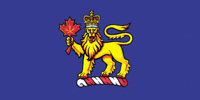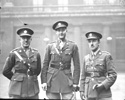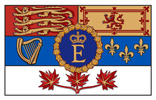

Have you ever wondered why a maple leaf was chosen for the National Flag of Canada? Follow this timeline to learn about some of the major moments in the evolution of the maple leaf as a symbol of Canada.
Did You Know? Today, the maple leaf is instantly recognized as the symbol of Canada. But it wasn’t always the case! In fact, thanks to the expanding fur trade 400 years ago, the first popular Canadian symbol was… the beaver!


The maple tree with its vibrant autumn colours has always been a prominent feature of the landscape in the eastern parts of Canada. The Indigenous peoples living in these areas valued the maple tree for its sweet sap and the goods derived from it. While this remarkable tree made a distinct impression on early settlers, it wasn’t until the 19th century that the maple leaf itself emerged as a symbol of national identity. From that time onwards, the leaf appeared more and more frequently, becoming the well-loved symbol of Canada it is today.

Founding of the Société Saint-Jean-Baptiste, an association celebrating French Canadian language and culture, which adopts the maple leaf as an emblem.


The newspaper Le Canadien adds a wreath of maple leaves to its front page. In the editor’s words, “the maple leaf has been […] adopted as the emblem of Lower Canada.”

The literary annual The Maple-Leaf refers to the maple leaf as “the chosen emblem for Canada” and features a golden leaf on the cover.

A maple leaf appears on the cover page of Canada’s first comic journal, Punch in Canada . Other magazines start to use this increasingly popular symbol, such as The Maple Leaf: A Juvenile Monthly Magazine (1852) and The Illustrated Maple Leaf (1854).


Canadian pennies feature maple leaves starting in the 1850s and, from 1876 to 1901, the maple leaf appears on all Canadian coins. The design of the 1¢ coin remains unchanged from 1937 until it is taken out of circulation in 2012.

The maple leaf features on the badge of the 100th (Prince of Wales’ Royal Canadian) Regiment of Foot and in decorations for the visit of the Prince of Wales to Canada.

Canadian poet and songwriter Alexander Muir composes the patriotic song The Maple Leaf Forever to commemorate Confederation. It is widely used as an unofficial national song for decades afterwards and remains popular in many English-speaking parts of Canada until the official adoption of O Canada as our national anthem in 1980.

The maple leaf is included on the shields of the coats of arms granted by Queen Victoria for both Quebec and Ontario.

The Governor General's flag is formally adopted and features a wreath of maple leaves. The current Governor General’s flag shows the crest of the coat of arms of Canada: a crowned golden lion holding a red maple leaf.


Canadian soldiers fighting for Britain in the Boer War in South Africa wear a maple leaf badge on their helmets.


Beginning with the London games in 1908, the maple leaf is featured on all Canadian Olympic uniforms. These first uniforms feature a single red maple leaf on a white background.

From 1910 to 1913 the Montréal Canadiens hockey jersey features a maple leaf design.

Canadian military personnel wear maple leaf badges and also display the maple leaf on their equipment.


In discussions leading to the creation of Canada’s new coat of arms, Major-General Eugène Fiset, Canada’s Surgeon General during the First World War and later Lieutenant Governor of Quebec, recommends a number of concepts for Canada’s official emblem. Among his many proposals is a single red maple leaf on a white field.

King George V grants the official Royal Arms of Canada. They feature a sprig of three green maple leaves on the shield and a red maple leaf in the crest.

The Toronto Maple Leafs hockey team adopts the maple leaf as its logo.

Many Canadian military units display the maple leaf on their badges and equipment. During the war, the Canadian Army also publishes a newspaper for its troops, called the Maple Leaf .

Queen Elizabeth II wears the "Maple Leaf of Canada dress" at a state banquet at Rideau Hall. The gown features a garland of maple leaves mingled with white roses. Also in this year, the three maple leaves on Canada’s coat of arms are changed from green to red.

Queen Elizabeth II approves a personal flag for use when she is in Canada. Modeled on Canada’s coat of arms, it features a sprig of three maple leaves.


The Great Flag Debate. Most of the thousands of flag concepts submitted by Canadians feature a maple leaf.

The iconic maple leaf becomes the centerpiece of Canada’s new National Flag, raised for the first time on February 15, 1965.